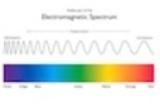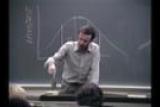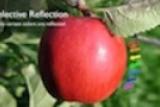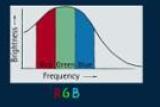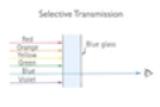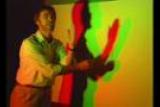Conceptual Physical Science
Chapter 11: Light
Color in Our World
Visible light is a small segment of the electromagnetic spectrum. Duration: 2:14.
Why Sunsets are Red
Using tuning forks, Hewitt demonstrates why we see certain colors when we look skyward. Duration: 8:55.
Selective Reflection
The color of an object depends upon the light source. Duration: 2:00.
Blue Sky, Red Sunsets, White Clouds
This video describes why the sky is blue, sunsets red, and clouds white. Duration: 6:58.
Mixing Colored Lights
The rules for combining colors is related to the radiation curve for sunlight. Duration: 7:12.
Selective Transmission
The color of a transparent material results from selective absorption. Duration: 0:57.
Mixing Color Pigments
Mixing paints causes a change in color by way of a subtraction of select frequencies of light. Duration: 1:48.
Watch these additional videos to complete this tutorial.
Table of Videos
- Chapter 1: Patterns of Motion
- Chapter 2: Newton's Laws of Motion
- Chapter 3: Momentum and Energy
-
Chapter 4: Gravity, Projectiles, and Satellites
- 4.1 The Universal Law of Gravity
- 4.2 Gravity and Distance: The Inverse-Square Law
- 4.3 Weight and Weightlessness
- 4.4 Universal Gravitation
- 4.5 Projectile Motion
- 4.6 Fast-Moving Projectiles—Satellites
- 4.7 Circular Satellite Orbits
- 4.8 Elliptical Orbits
- 4.9 Escape Speed
-
Chapter 5: Fluid Mechanics
- 5.1 Density
- 5.2 Pressure
- 5.3 Buoyancy in a Liquid
- 5.4 Archimedes’ Principle
- 5.5 Pressure in a Gas
- 5.6 Atmospheric Pressure
- 5.7 Pascal’s Principle
- 5.8 Buoyancy in a Gas
- 5.9 Bernoulli’s Principle
-
Chapter 6: Thermal Energy
- 6.1 Temperature
- 6.2 Absolute Zero
- 6.3 Heat
- 6.4 Quantity of Heat
- 6.5 The Laws of Thermodynamics
- 6.6 Entropy
- 6.7 Specific Heat Capacity
- 6.8 Thermal Expansion
- 6.9 Expansion of Water
-
Chapter 7: Heat Transfer and Phase Change
- 7.1 Conduction
- 7.2 Convection
- 7.3 Radiation
- 7.4 Newton’s Law of Cooling
- 7.5 Climate Change and the Greenhouse Effect
- 7.6 Heat Transfer and Change of Phase
- 7.7 Boiling
- 7.8 Melting and Freezing
- 7.9 Energy and Change of Phase
-
Chapter 8: Electricity
- 8.1 Electric Force and Charge
- 8.2 Coulomb’s Law
- 8.3 Electric Field
- 8.4 Electric Potential
- 8.5 Voltage Sources
- 8.6 Electric Current
- 8.7 Electric Resistance
- 8.8 Ohm’s Law
- 8.9 Electric Circuits
- 8.10 Electric Power
-
Chapter 9: Magnetism
- 9.1 Magnetic Poles
- 9.2 Magnetic Fields
- 9.3 Magnetic Domains
- 9.4 Electric Currents and Magnetic Fields
- 9.5 Magnetic Forces on Moving Charges
- 9.6 Electromagnetic Induction
- 9.7 Generators and Alternating Current
- 9.8 Power Production
- 9.9 The Transformer—Boosting or Lowering Voltage
- 9.10 Field Induction
-
Chapter 10: Waves and Sound
- 10.1 Vibrations and Waves
- 10.2 Wave Motion
- 10.3 Transverse and Longitudinal Waves
- 10.4 Sound Waves
- 10.5 Reflection and Refraction of Sound
- 10.6 Forced Vibrations and Resonance
- 10.7 Interference
- 10.8 Doppler Effect
- 10.9 Bow Waves and the Sonic Boom
- 10.10 Musical Sounds
-
Chapter 11: Light
- 11.1 Electromagnetic Spectrum
- 11.2 Transparent and Opaque Materials
- 11.3 Reflection
- 11.4 Refraction
- 11.5 Color
- 11.6 Dispersion
- 11.7 Polarization
-
Chapter 12: Atoms and the Periodic Table
- 12.1 Atoms Are Ancient and Empty
- 12.2 The Elements
- 12.3 Protons and Neutrons
- 12.4 The Periodic Table
- 12.5 Physical and Conceptual Models
- 12.6 Identifying Atoms Using the Spectroscope
- 12.7 The Quantum Hypothesis
- 12.8 Electron Waves
- 12.9 The Shell Model
-
Chapter 13: The Atomic Nucleus
- 13.1 Radioactivity
- 13.2 The Strong Nuclear Force
- 13.3 Half-Life and Transmutation
- 13.4 Radiometric Dating
- 13.5 Nuclear Fission
- 13.6 Mass-Energy Equivalence
- 13.7 Nuclear Fusion
-
Chapter 14: Elements of Chemistry
- 14.1 Chemistry: The Central Science
- 14.2 The Submicroscopic World
- 14.3 Physical and Chemical Properties
- 14.4 Determining Physical and Chemical Changes
- 14.5 Elements to Compounds
- 14.6 Naming Compounds
- 14.7 The Advent of Nanotechnology
-
Chapter 15: Bonds and Molecular Attractions
- 15.1 Electron-Dot Structures
- 15.2 The Formation of Ions
- 15.3 Ionic Bonds
- 15.4 Metallic Bonds
- 15.5 Covalent Bonds
- 15.6 Polar Covalent Bonds
- 15.7 Molecular Polarity
- 15.8 Molecular Attractions
-
Chapter 16: Mixtures
- 16.1 Most Materials Are Mixtures
- 16.2 The Chemist's Classification of Matter
- 16.3 Solutions
- 16.4 Solubility
- 16.5 Soaps, Detergents, and Hard Water
- 16.6 Purifying the Water We Drink
- 16.7 Wastewater Treatment
-
Chapter 17: How Chemicals React
- 17.1 Chemical Equations
- 17.2 Counting Atoms and Molecules by Mass
- 17.3 Reaction Rates
- 17.4 Catalysts
- 17.5 Energy and Chemical Reactions
- 17.6 Chemical Reactions Are Driven by Entropy
-
Chapter 18: Acids/Bases and Redox
- 18.1 Acids Donate Protons; Bases Accept Them
- 18.2 Relative Strengths of Acids and Bases
- 18.3 Acidic, Basic, and Neutral Solutions
- 18.4 Acidic Rain and Basic Oceans
- 18.5 Losing and Gaining Electrons
- 18.6 Harnessing the Energy of Flowing Electrons
- 18.7 Electrolysis
- 18.8 Corrosion and Combustion
-
Chapter 19: Organic Compounds
- 19.1 Hydrocarbons
- 19.2 Unsaturated Hydrocarbons
- 19.3 Functional Groups
- 19.4 Alcohols, Phenols, and Ethers
- 19.5 Amines and Alkaloids
- 19.6 Carbonyl Compounds
- 19.7 Polymers
-
Chapter 20: Rocks and Minerals
- 20.1 The Geosphere is Made Up of Rocks and Minerals
- 20.2 Minerals
- 20.3 Mineral Properties
- 20.4 Classification of Rock-Forming Minerals
- 20.5 The Formation of Minerals
- 20.6 Rock Types
- 20.7 Igneous Rocks
- 20.8 Sedimentary Rocks
- 20.9 Metamorphic Rocks
- 20.10 The Rock Cycle
-
Chapter 21: Plate Tectonics
- 21.1 Seismic Waves
- 21.2 Earth’s Internal Layers
- 21.3 Continental Drift—An Idea Before its Time
- 21.4 Acceptance of Continental Drift
- 21.5 The Theory of Plate Tectonics
- 21.6 Continental Evidence for Plate Tectonics
- 21.7 The Theory That Explains the Geosphere
-
Chapter 22: Shaping Earth's Surface
- 22.1 The Hydrologic Cycle
- 22.2 Groundwater
- 22.3 The Work of Groundwater
- 22.4 Surface Water and Drainage Systems
- 22.5 The Work of Surface Water
- 22.6 Glaciers and Glaciation
- 22.7 The Work of Glaciers
- 22.8 The Work of Air
-
Chapter 23: Geologic Time
- 23.1 The Rock Record—Relative Dating
- 23.2 Radiometric Dating
- 23.3 Geologic Time
- 23.4 Precambrian Time (4500 to 543 Million Years Ago)
- 23.5 The Paleozoic Era (543 to 248 Million Years Ago)
- 23.6 The Mesozoic Era (248 to 65 Million Years Ago)
- 23.7 The Cenozoic Era (65 Million Years to the Present)
- 23.8 Earth History in a Capsule
-
Chapter 24: The Oceans and Atmosphere
- 24.1 Earth’s Atmosphere and Oceans
- 24.2 Components of Earth’s Oceans
- 24.3 Ocean Waves, Tides, and Shorelines
- 24.4 Components of Earth’s Atmosphere
- 24.5 Solar Energy
- 24.6 Driving Forces of Air Motion
- 24.7 Global Circulation Patterns
-
Chapter 25: Driving Forces of Weather
- 25.1 Atmospheric Moisture
- 25.2 Weather Variables
- 25.3 Cloud Development
- 25.4 Air Masses, Fronts, and Storms
- 25.5 Violent Weather
- 25.6 The Weather, Topic of Conversation
-
Chapter 26: The Solar System
- 26.1 The Solar System and its Formation
- 26.2 The Sun and Seasons
- 26.3 The Inner Planets
- 26.4 The Outer Planets
- 26.5 Earth's Moon
- 26.6 Failed Planet Formation
-
Chapter 27: Stars and Galaxies
- 27.1 Observing the Night Sky
- 27.2 The Brightness and Color of Stars
- 27.3 The Hertzsprung-Russell Diagram
- 27.4 The Life Cycles of Stars
- 27.5 Black Holes
- 27.6 Galaxies
-
Chapter 28: Space and Time
- 28.1 Looking Back in Time
- 28.2 Cosmic Inflation
- 28.3 and 28.4 Relativity
- 28.5 Dark Matter
- 28.6 Dark Energy
- 28.7 The Fate of the Universe
-
Review
- Review 1
- Review 2
- Review 3
- Review 4
- Review 5

